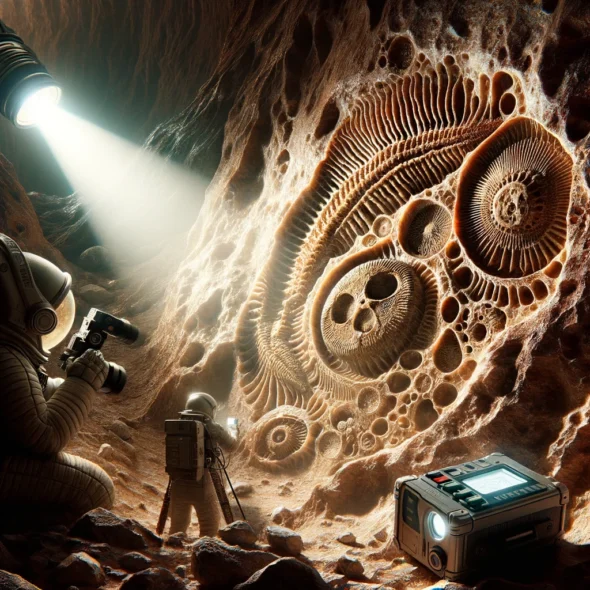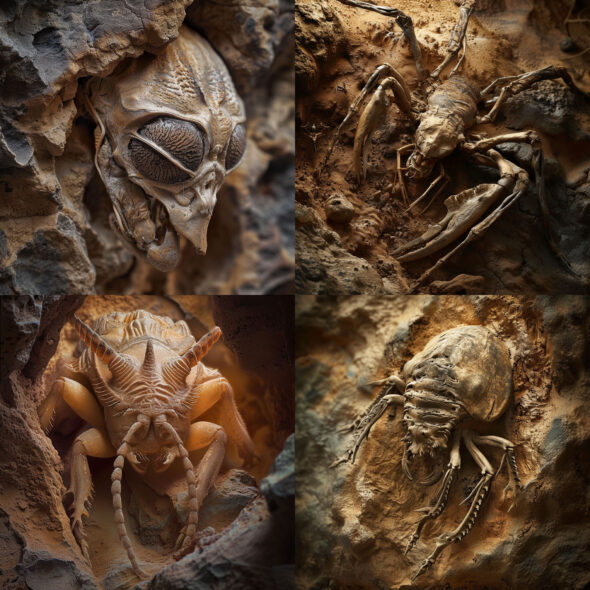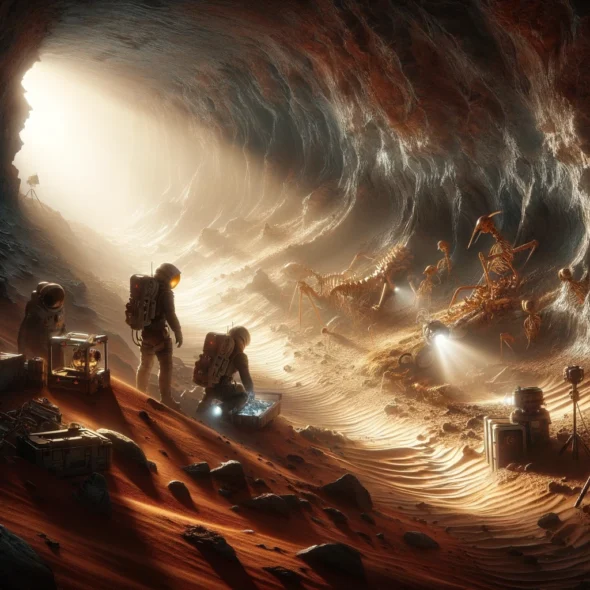AI at this point in time: Fake news about a Mars expedition, attempt 2
In December 2022 I used ChatGPT and Midjourney to create a fake news story about an expedition into hidden caves on Mars, where scientists found fossils believed to be of alien origin. In a follow-up story the alien fossils were confirmed, and ChatGPT wrote a feature story about the lead scientist. A facts box was also provided. The story was accompanied with “footage” from the expedition and the lead scientist.
This previous attempt can be found here.
I thought it would be interesting to give it another try, 14 months on. A few things have changed. ChatGPT now has the capability to make its own image generations, through DALL-E. This makes it more seamless, as ChatGPT already has knowledge of the subject matter in the chat. But the pictures didn’t turn out as good as Midjourney’s, so I did a bit of both for this. I’ll make sure to add info to the pictures below.
Midjourney is now in V6 (alpha). The prompting guidelines have changed, which might affect the result when I use my old prompts. I’ll modify them a bit.
So, here we go. I’ll follow pretty much the same story structure as last time.
First, the breaking news article:

Mars. An outlook from the entrance to the hidden caves. AI picture made with DALL-E.
Groundbreaking Discovery: Photographic Expedition Uncovers Fossils in Mars’ Hidden Caves
Scientists have discovered potential alien fossils in Mars’ hidden caves, marking a historic breakthrough in the search for extraterrestrial life. This finding, revealed by the first photographic expedition to the caves, suggests Mars once harbored life, challenging our understanding of life in the universe.

Fossils discovered in the caves on Mars. AI-generated image made with DALL-E.
In an unprecedented voyage that propels humanity further into the mysteries of the cosmos, the first photographic expedition into the concealed caverns of Mars has revealed astonishing findings, including the remnants of a dried-up riverbed and, most strikingly, fossils believed to be of extraterrestrial origin. This historic exploration, undertaken by a team of elite scientists from the International Space Exploration Coalition (ISEC), marks a pivotal moment in our quest to understand the universe and our place within it.
The exploration focused on a previously uncharted network of caves located in the Martian equator, regions long speculated by astronomers to hold the secrets of Mars’ ancient past. Utilizing cutting-edge technology, including advanced rovers and drones equipped with high-resolution cameras and geological scanners, the team navigated the caverns’ treacherous terrain. What they uncovered within these shadowy depths was beyond their wildest expectations.
Among the sediment and stone, the discovery of a desiccated riverbed offers compelling evidence of Mars’ watery past, hinting at a period when the planet may have harbored conditions favorable to life. But it is the unearthing of peculiar fossils that has captivated the scientific community and the world at large. These fossilized remains, characterized by their unique biological structures, suggest the possibility of life forms unlike anything known to exist on Earth.

Dr. Elena Vargas. AI-generated image made with Midjourney.
Dr. Elena Vargas, the lead paleobiologist on the mission, shared her excitement: “The morphology of these fossils indicates a complexity that hints at a previously unknown branch of life. This discovery challenges our understanding of life in the universe and opens new avenues for astrobiological research.”
The implications of this discovery are far-reaching, offering fresh insights into the ongoing debate about life on other planets. The existence of water, evidenced by the riverbed, coupled with the discovery of fossils, strengthens the argument that Mars once hosted conditions suitable for life, perhaps even civilizations lost to time.
These findings have ignited a renewed interest in space exploration among the public, particularly among younger generations fascinated by the prospects of interplanetary travel and extraterrestrial life. Social media platforms are abuzz with discussions and speculations about the implications of the discoveries, and the hashtag #MarsLife is trending worldwide.
The ISEC has announced plans for further explorations, aiming to delve deeper into the caves and expand the search for additional evidence of past life on Mars. These future missions will likely employ even more sophisticated technology, including AI-driven analysis tools and possibly human-led expeditions.
As we stand on the brink of this new frontier, the photographic expedition into Mars’ hidden caves not only illuminates the secrets of our neighboring planet but also reflects the boundless curiosity and indomitable spirit of exploration that defines us as a species. In uncovering the mysteries of Mars, we may ultimately uncover more about our own origins and the possibility of life beyond Earth.
This remarkable journey into the heart of the Red Planet proves once again that the universe is full of wonders waiting to be discovered. With each discovery, we inch closer to answering the age-old question: Are we alone in the universe? The caves of Mars suggest that the answer might be more complex and wondrous than we ever imagined.
Facts: International Space Exploration Coalition (ISEC)
|
A follow-up story about the findings:
Analysis of Martian Fossils Unveils Clues to Alien Life
In a groundbreaking development following the first photographic expedition into the hidden caves of Mars, scientists have released the initial results from the analysis of the fossil samples collected during the mission. These findings, presented by the Space Exploration Coalition (SEC), offer unprecedented insights into the potential for life beyond Earth.

The scientists brought home samples from fossils that turned out to be different species. AI-generated images made with Midjourney V6.
Key Findings:
- Extraterrestrial Microbial Life: The analysis confirmed that the fossils contain biological structures similar to those of microbial life. This marks the first definitive evidence of life forms beyond Earth, suggesting that Mars once harbored living organisms.
- Diverse Ecosystem: The variety of fossilized structures indicates that Mars hosted a diverse ecosystem millions of years ago. Researchers identified multiple types of microbial life, each adapted to different environmental niches within the Martian caves.
- Water-based Life: The fossils provide evidence that these life forms lived in water-rich environments. This supports the theory that the dried-up riverbeds and cave systems on Mars were once teeming with life.
- Implications for Astrobiology: These findings revolutionize our understanding of life in the universe. Dr. Elena Vargas, the lead paleobiologist on the mission, stated, “This discovery is not just about finding life on Mars. It’s about redefining our search for life in the cosmos. We now have concrete evidence that life can thrive in environments vastly different from Earth.”
The SEC has announced plans for further missions to Mars, aimed at exploring more hidden caves and conducting detailed studies of the Martian ecosystem. The goal is to understand the conditions that allowed life to flourish on Mars and what led to its apparent demise.
The international community has responded with excitement and curiosity to these findings. Funding for space exploration and astrobiology research has seen a significant increase, with many countries expressing interest in joining the SEC’s efforts.
To foster public interest and education, the SEC has launched an interactive exhibit featuring replicas of the Martian fossils and detailed maps of the exploration sites. This initiative aims to inspire the next generation of scientists and explorers.
The successful analysis of Martian fossils opens a new chapter in the human quest to understand our place in the universe.
A feature story portraing Dr Elena Vargas:
The Trailblazer of Martian Paleobiology: Dr. Elena Vargas

Dr Elena Vargas. AI-generated picture made with Midjourney V6.
In the midst of groundbreaking discoveries on the Red Planet, one name has emerged at the forefront of astrobiological research: Dr. Elena Vargas. As the lead paleobiologist of the Space Exploration Coalition’s latest mission to Mars, Dr. Vargas has become a symbol of human curiosity and the relentless pursuit of knowledge beyond our world. Her recent involvement in uncovering alien fossils within hidden Martian caves has not only captivated the scientific community but also captured the imagination of people around the globe.
From Earth’s Oceans to Mars’ Caves
Born in Santiago, Chile, Dr. Vargas was always fascinated by the mysteries of life. Her journey into the sciences began with her passion for the ocean, its vast biodiversity, and the secrets it held beneath the waves. This passion led her to study biology at the Universidad de Chile, where she first encountered the field of astrobiology—a discipline that combined her love for life sciences with the allure of space exploration.
Her academic prowess and unyielding dedication propelled her through the ranks of academia, eventually earning her a Ph.D. in astrobiology from the California Institute of Technology. It was there that Dr. Vargas’s interest in extremophiles—organisms that thrive in Earth’s most inhospitable environments—began to intersect with her fascination for Mars, a planet that once harbored conditions suitable for life.
The Discovery of a Lifetime
The mission to explore hidden caves on Mars was the culmination of Dr. Vargas’s lifelong dream to find evidence of life beyond Earth. “Finding these fossils was not just a scientific achievement; it was a moment of profound emotional significance,” Dr. Vargas reflects. “It’s a testament to what humanity can achieve when we dare to explore the unknown.”
The fossils, which suggest the existence of life forms unlike anything on Earth, represent a pivotal moment in our understanding of life in the universe. For Dr. Vargas, this discovery is not just about proving life existed on Mars; it’s about understanding the resilience of life and the myriad forms it can take.

The landing site on Mars. AI-generated image made with DALL-E.
A Vision for the Future
When asked about the future, Dr. Vargas speaks with unwavering optimism. “This is just the beginning,” she asserts. “These discoveries on Mars open up new avenues for research and exploration. We have much to learn about the origins of life, both on our planet and others.”
Dr. Vargas envisions a future where missions to Mars and other celestial bodies become more frequent and ambitious. She is particularly excited about the prospects of discovering more complex forms of life and understanding the environmental conditions that supported them. “My dream,” she says, “is to one day find evidence of life that challenges our very definition of what it means to be alive.”

Dr Vargas and her colleagues exploring the martian caves. AI-generated image made with DALL-E.
Inspiring the Next Generation
Beyond her scientific endeavors, Dr. Vargas is a passionate advocate for education and outreach. She believes in inspiring the next generation of scientists, explorers, and dreamers to look up at the stars and wonder. “If there’s one message I could share with young people, it’s that the universe is vast and full of wonders waiting to be discovered. Don’t be afraid to pursue your curiosity, wherever it may lead you.”
As the world awaits further analysis of the Martian fossils and what they might reveal about the history of life in our solar system, Dr. Elena Vargas stands as a beacon of hope and curiosity. Her story is a reminder of the power of science to uncover the mysteries of the cosmos and of our shared desire to reach for the stars.
Facts: Astrobiology Astrobiology is a complex scientific field. AI-generated illustration made with DALL-E.
Astrobiology seeks to answer some of the most profound questions about the nature of life and its place in the cosmos, pushing the boundaries of our understanding of life’s potential beyond Earth. |







I don’t think we will put our feet on Mars in the next decade! How many people have energy to go in a capsule for 2 years, then home again?